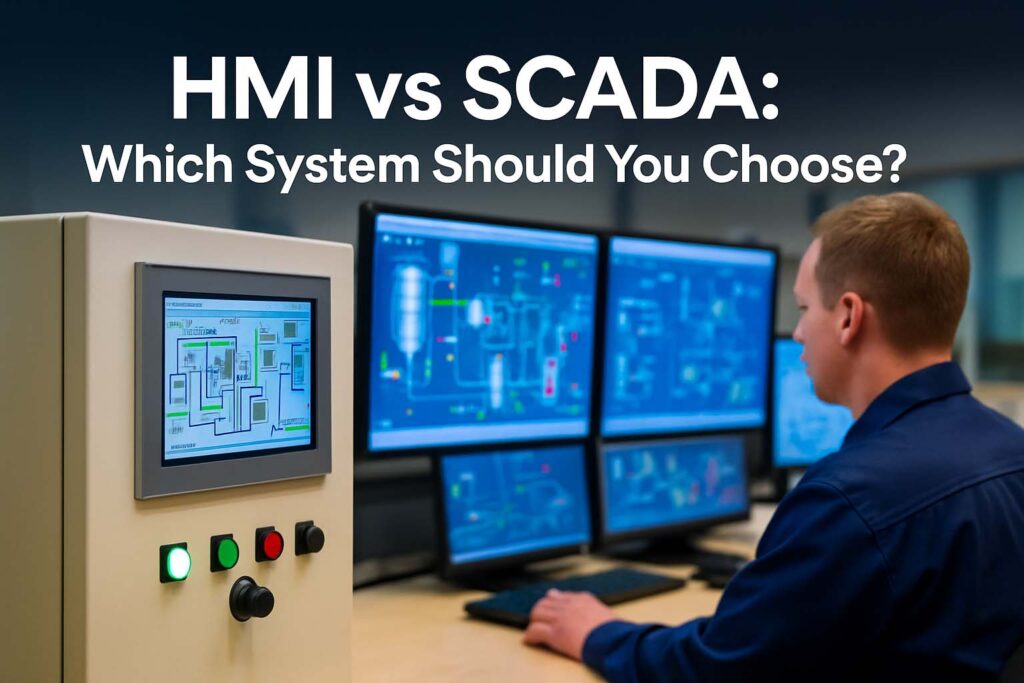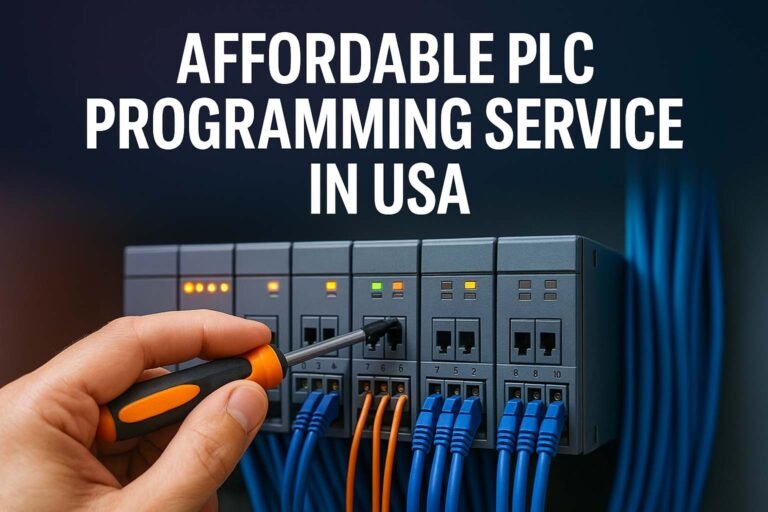HMI vs SCADA: Which System Should You Choose?
In the world of industrial automation, the terms HMI (Human Machine Interface) and SCADA (Supervisory Control and Data Acquisition) are often used interchangeably. While they both play crucial roles in monitoring and controlling industrial processes, they are not the same. Understanding the difference between HMI and SCADA is key to selecting the right system for your operations.
Table of Contents
Table of Contents

Choosing between HMI and SCADA depends on many factors—scale of operation, level of control, data needs, and long-term flexibility. Both systems are essential for making modern factories smarter and more efficient. However, each has its unique strengths and limitations.
Let’s dive deep into the differences, applications, benefits, and key considerations to help you decide: HMI vs SCADA — which system is right for you?
Key Takeaways: HMI vs SCADA
- HMI is a graphical interface that operators use to interact with machines and devices on the factory floor.
- SCADA is a broader control system that includes HMIs, data collection, remote monitoring, and higher-level management functionalities.
- Choose HMI for localized, simple operations. Choose SCADA for large-scale, data-intensive, or geographically dispersed systems.
Understanding HMI: What It Does Best
HMI, or Human Machine Interface, is exactly what it sounds like—a bridge between humans and machines. It provides a graphical display of the machine’s operations. Think of it as a touch screen on a packaging machine or a dashboard showing temperatures, pressures, or motor speeds.
An HMI is typically installed near the machine or control panel. Operators use it to monitor current conditions and manually control equipment like starting or stopping a motor or adjusting setpoints.
It focuses on real-time data, and its main function is to provide an intuitive way for plant operators to interact with programmable logic controllers (PLCs). HMIs are often limited in historical data logging or analytics capabilities.
Common industries using HMI include manufacturing, water treatment, packaging, and energy.
Know more about Modbus Communication Protocol: Master-Slave Explained
What Is SCADA and How Is It Different?
SCADA stands for Supervisory Control and Data Acquisition. It is a more comprehensive system that includes not only the HMI but also data collection, real-time monitoring, alarm handling, trending, and sometimes control of multiple sites.
Unlike HMI, which interacts with a single PLC or machine, SCADA can manage and supervise entire plants or multiple remote facilities. SCADA integrates with databases, enterprise systems, and even cloud platforms. It allows managers to view historical data, trends, and reports across long periods and locations.
For example, in a water utility, a SCADA system may monitor pump stations across a large geographical region. It collects data continuously and alerts supervisors if something is out of the norm.
HMI vs SCADA – Feature Comparison Table
| Feature | HMI | SCADA |
|---|---|---|
| Scope | Single machine or small process | Multiple machines/sites, large-scale plant |
| Data Logging | Limited or none | Extensive, long-term storage |
| Control Capabilities | Local control | Local + remote supervisory control |
| Real-Time Monitoring | Yes | Yes |
| Historical Data Analysis | Rare or basic | Comprehensive |
| Alarm Handling | Basic | Advanced with escalation |
| Connectivity | Limited (one or few PLCs) | Wide (many PLCs, RTUs, servers) |
| Cost | Lower | Higher |
| Suitable For | Small factories, standalone machines | Utilities, large plants, smart factories |
Know more about Best Programmable Logic Controller Manufacturers
When Should You Choose an HMI?
An HMI is the ideal choice when your operations are limited to a single machine or a local control system. It’s cost-effective, simple, and quick to deploy.
For example, in a small bottling plant, an HMI screen can let an operator start the conveyor belt, monitor the filling process, and shut the machine down in case of a jam. You don’t need a full SCADA system for such operations.
Use HMI when:
- You have localized equipment that doesn’t require remote monitoring.
- You don’t need complex data logging or analysis.
- Budget is limited and operational simplicity is key.
- System is operated by on-site technicians directly interacting with the machinery.
When Should You Go for SCADA?
If your plant has multiple processes, geographical dispersion, or the need for centralized data control, SCADA becomes essential. It not only monitors but supervises operations at scale.
In the oil and gas industry, SCADA systems collect real-time flow data from pipelines, monitor tank levels, and send alerts to central control rooms. Data is also stored for analytics and compliance purposes.
SCADA is right when:
- You need remote visibility and control over large operations.
- Data analysis and reporting are important for decision-making.
- Regulatory requirements demand historical data logs.
- Alarm management and predictive maintenance are priorities.
- Integration with ERP or MES systems is needed.
Know more about Programmable Logic Controller Components
HMI vs SCADA in Industrial Automation
Both HMI and SCADA play central roles in modern automation. HMIs offer a real-time, hands-on interface that improves operator productivity and machine performance. SCADA, on the other hand, is the digital nervous system of an entire industrial operation.
In automated factories, HMI is often embedded within the SCADA system. Operators use HMI to view what’s happening on the machine level. Engineers and managers use SCADA dashboards to track KPIs, production efficiency, and overall plant health.
The real power lies in integration. SCADA systems often host multiple HMI stations, distributed over various departments. This gives both micro and macro-level control across the facility.
Is SCADA Replacing HMI?
Not at all. SCADA and HMI are complementary. SCADA systems use HMIs as the interface layer. Without HMI, SCADA has no direct user interaction. The trend is not to replace but to combine both technologies in smarter ways.
Today, cloud-based SCADA and web-based HMI are emerging. This allows operators to access systems remotely via laptops or smartphones. However, the basic roles remain unchanged.
Know more about Programmable Logic Controller Components
Technical Insights: Architecture of HMI vs SCADA
Here’s a look at how their architecture differs.
HMI Architecture
- HMI Panel
- PLC/Controller
- Local sensors/actuators
SCADA Architecture
- Central Server (SCADA software)
- Multiple HMI Clients
- PLCs/RTUs at various sites
- Communication networks (Ethernet, Modbus, OPC)
- Historian database
- Alarm system
- Web/cloud integration (optional)
In HMI systems, data flows in real-time between PLC and the display. In SCADA, data is transmitted, processed, stored, and visualized across various devices and user levels.
Know more about Programmable Logic Controller Types
Cost Considerations: HMI vs SCADA
Cost is a major factor in choosing between the two.
HMI Costs:
- Generally lower upfront costs
- Licenses per screen or panel
- Less expensive hardware
- Low maintenance
SCADA Costs:
- Higher software licensing costs
- Requires server infrastructure
- Ongoing support and upgrades
- Training needed for users
If your operation is small or mid-sized, HMI may save money. But for growing businesses, SCADA offers more in terms of future scalability.
Security in HMI vs SCADA
Cybersecurity has become a key concern in industrial automation. HMIs, being local, are generally less exposed. SCADA systems, especially when connected to the internet, need robust cybersecurity.
Modern SCADA platforms include:
- User access control
- Encrypted communication
- Firewall protection
- Audit trails
Choosing a SCADA system means you must invest in network and data security as well.
Future of HMI and SCADA
The future is integration and mobility. HMI and SCADA systems are becoming smarter with AI and IoT. With predictive maintenance, smart alarms, and cloud analytics, SCADA systems are leading the fourth industrial revolution.
Web-based HMIs allow access through any browser. Mobile SCADA apps help supervisors check plant status while off-site. The trend is toward unified platforms combining machine control, analytics, and business intelligence.
Know more about Programmable Logic Controller vs Arduino
Conclusion: HMI vs SCADA — Which One Should You Choose?
If your operation is small and local, and you just need a simple way to control or monitor a machine, an HMI is enough. It’s cost-effective, easy to use, and gets the job done.
If your plant spans multiple machines, sites, or needs central monitoring, SCADA is the better investment. It provides remote access, better data handling, alarm management, and scalability.
In many cases, you’ll need both. Think of HMI as the eyes and hands, and SCADA as the brain and memory of your industrial operation.
Follow Us on Social:
Subscribe our Newsletter on Electrical Insights to get the latest updates in Electrical Engineering.
#HMIvsSCADA, #HMI, #SCADA, #IndustrialAutomation, #ControlSystems, #SCADAsoftware, #HMIsoftware, #AutomationEngineering, #PLCProgramming, #FactoryAutomation, #ProcessControl, #IndustrialTech, #SCADAvsHMI, #AutomationSystems, #SmartManufacturing






